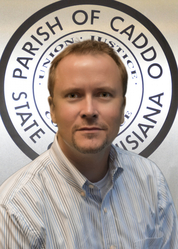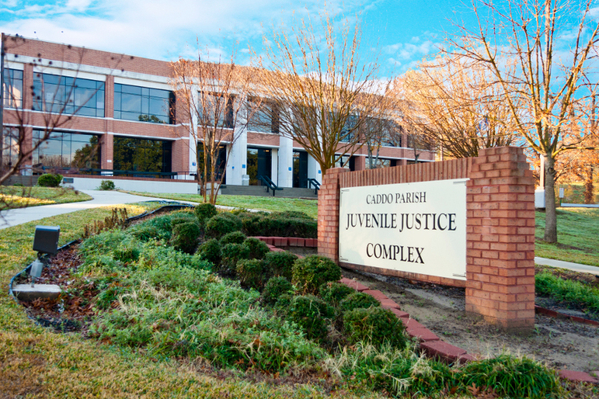[Photo: Lex Talamo, Shreveport Times]
The first time Clay Walker, director of Caddo Parish Juvenile Services, heard about the science of adverse childhood experiences was in 2014, during a one-hour presentation from a state health department worker. Although he’d attended several conferences about adolescent trauma, this was the first time Walker heard about ACEs.
His reaction was immediate. “My jaw was on the floor,” he recalls. “It was the science behind the kids I had worked with for 15 years. It validated everything I had seen.”
He asked the presenter for training and was invited to the state’s first ACEs train-the-trainers three-day session with Dr. Robert Anda, co-principal investigator of the CDC-Kaiser Permanente Adverse Childhood Experiences Study, and Laura Porter, who pioneered integrating ACEs science in communities in Washington State in the early 2000s.
“The training blew me away,” he says, noting that he was the only person from northwest Louisiana in that first cohort.
Walker’s start in civil rights
Walker didn’t start out in juvenile justice, but he says he got lucky because of his family. Both his father and stepmother were civil rights attorneys, and after earning his law degree at Northeastern University in Boston in 1998, he joined their firm.
“I did their research and writing,” he says, which left him free to take on pro bono work in juvenile cases. “Ninety percent of my cases were pro bono juvenile work, and they were tough cases.”
Working as a civil rights attorney “eventually boils down to making settlements,” Walker says, explaining why he decided to transition to full-time juvenile work. “It wasn’t working for me.”
In 2011, after serving three years as Louisiana’s first director of juvenile public defender services overseeing all 64 parishes in the state, Clay Walker returned to Shreveport, in Caddo Parish, to oversee the juvenile detention center and juvenile probation. (A parish is the same as a county.)
 “I felt I could be more effective overseeing juvenile detention and probation than in my role as the state juvenile defender,” he says. “I felt I could have a deeper impact in Caddo, in Shreveport, focusing on a smaller area, than overseeing the entire state.”
“I felt I could be more effective overseeing juvenile detention and probation than in my role as the state juvenile defender,” he says. “I felt I could have a deeper impact in Caddo, in Shreveport, focusing on a smaller area, than overseeing the entire state.”
Caddo Parish has approximately 240,000 citizens, with a student population of roughly 36,000, 65 percent of which is African American. The parish has a very high poverty rate, with approximately 38% of children under the age of five living below the poverty level.
Implementing ACEs in Caddo Schools
Since 2014, Walker’s staff in juvenile detention and probation have all been trained in ACEs and trauma prevention. “Our goal,” he says, “is to rehabilitate children and reduce recidivism. To do this, you’ve got to understand the trauma these kids have suffered.”
But it was the realization that criminal prevention needed to start in the schools that got Walker on the ACEs bandwagon. He wanted to do something about the school-to-prison pipeline.
“The biggest breakthrough we had was the hiring of the new school superintendent,” Walker says, speaking of his collaboration with Dr. Lamar Goree, Caddo’s school superintendent hired in 2013.
The school district and the juvenile court began to collaborate on a trauma-informed philosophy about prevention and giving children second chances. Goree and Walker formed a plan to make Caddo a trauma-informed school district incorporating ACEs training. Since that time, school-based arrests in the district have fallen more than 62%.
Extending ACEs to the Justice System
When he began overseeing the Caddo Juvenile Detention Center, Walker saw a daily population of 52 children in a 24-bed facility. There was a lot of fighting, with juveniles double bunked, and no attention was given to addressing trauma.
But when the state passed standards for juvenile detention centers by banning all chemical restraints, like mace, in 2013, and required larger cells for housing children, this meant that the cells at Caddo were too small for two children. Immediately, each cell was limited to one youth.
“That was the number one change that made things better,” says Walker, because it made the center safer and allowed juveniles the opportunity to sleep safely. Incidents of violence dropped by more than 60 percent and remained lower. They also added a full-time mental health counselor and a nurse.
“The second major change happened when Judge Matlock, Caddo’s chief juvenile judge overseeing all cases of abuse and neglect, took on a parish-wide effort to address the cycle of trauma in families. For years, the two discussed solutions and came to realize the best chance to address a child’s behavior is when you are also addressing the parents’ needs—usually a single mom’s needs.
“It’s a cycle of trauma,” Walker says. “We’re not turning a kid around until we turn mom around.”
Joining forces with the school superintendent and the chief judge, as well as with law enforcement and the Department of Children and Family Services, Walker helped create a parish-wide committee on trauma. The committee members developed assessment tools, a referral process, and evidence-based treatments. With the help of several grants, the court also invited the entire mental health community to become trained in trauma-informed treatment. In 2017, at the Governor’s Conference on Juvenile Justice in Baton Rouge, Walker received an award for Outstanding Contribution to Juvenile Justice and Delinquency Prevention.
A One-Stop Juvenile Treatment Center
With the help of the Annie Casey Foundation’s Juvenile Detention Alternatives Initiative as well as the MacArthur Foundation’s Models for Change, last year Caddo Parish reduced the detention population from 52 children a day to 19 children a day. Working with a 40-year-old local nonprofit, Volunteers for Youth Justice, the parish opened a Misdemeanor Referral Center, which acts as an alternative to detention as well as a school-fight diversion program. This helped reduce school arrests while more effectively addressing school fights.
The reform has ultimately culminated in a decision to move all of the parish’s juvenile justice programming to a new 55,000 square-foot building—The Harbor. It will house dozens of organizations serving juveniles, including the Misdemeanor Referral Center, truancy, chronically misbehaving youth, mental health agencies, and more. Opening this fall, The Harbor is a collaboration among the City of Shreveport, the Caddo school system, the Caddo Parish Commission, and the juvenile court. The goal is crime prevention, intervention, and suppression.
“Collaboration is the key,” says Walker, who is one of the state’s original instructors for trauma-informed care for children and has given hundreds of talks on ACEs throughout the state. “ACEs is the scientific foundation for it.”






Comments (0)